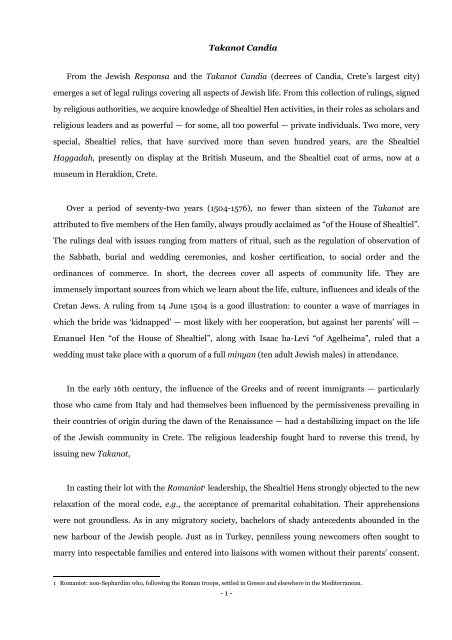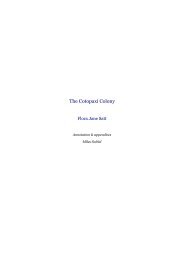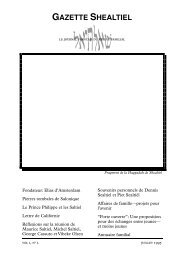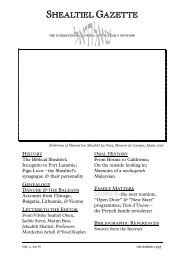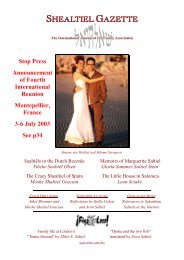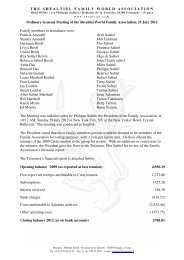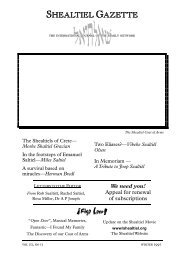please click here for his presentation - The Shealtiel Family Worldwide
please click here for his presentation - The Shealtiel Family Worldwide
please click here for his presentation - The Shealtiel Family Worldwide
Create successful ePaper yourself
Turn your PDF publications into a flip-book with our unique Google optimized e-Paper software.
Takanot Candia<br />
From the Jewish Responsa and the Takanot Candia (decrees of Candia, Crete’s largest city)<br />
emerges a set of legal rulings covering all aspects of Jewish life. From t<strong>his</strong> collection of rulings, signed<br />
by religious authorities, we acquire knowledge of <strong>Shealtiel</strong> Hen activities, in their roles as scholars and<br />
religious leaders and as powerful — <strong>for</strong> some, all too powerful — private individuals. Two more, very<br />
special, <strong>Shealtiel</strong> relics, that have survived more than seven hundred years, are the <strong>Shealtiel</strong><br />
Haggadah, presently on display at the British Museum, and the <strong>Shealtiel</strong> coat of arms, now at a<br />
museum in Heraklion, Crete.<br />
Over a period of seventy-two years (1504-1576), no fewer than sixteen of the Takanot are<br />
attributed to five members of the Hen family, always proudly acclaimed as “of the House of <strong>Shealtiel</strong>”.<br />
<strong>The</strong> rulings deal with issues ranging from matters of ritual, such as the regulation of observation of<br />
the Sabbath, burial and wedding ceremonies, and kosher certification, to social order and the<br />
ordinances of commerce. In short, the decrees cover all aspects of community life. <strong>The</strong>y are<br />
immensely important sources from which we learn about the life, culture, influences and ideals of the<br />
Cretan Jews. A ruling from 14 June 1504 is a good illustration: to counter a wave of marriages in<br />
which the bride was ‘kidnapped’ — most likely with her cooperation, but against her parents’ will —<br />
Emanuel Hen “of the House of <strong>Shealtiel</strong>”, along with Isaac ha-Levi “of Agelheima”, ruled that a<br />
wedding must take place with a quorum of a full minyan (ten adult Jewish males) in attendance.<br />
In the early 16th century, the influence of the Greeks and of recent immigrants — particularly<br />
those who came from Italy and had themselves been influenced by the permissiveness prevailing in<br />
their countries of origin during the dawn of the Renaissance — had a destabilizing impact on the life<br />
of the Jewish community in Crete. <strong>The</strong> religious leadership fought hard to reverse t<strong>his</strong> trend, by<br />
issuing new Takanot,<br />
In casting their lot with the Romaniot 1 leadership, the <strong>Shealtiel</strong> Hens strongly objected to the new<br />
relaxation of the moral code, e.g., the acceptance of premarital cohabitation. <strong>The</strong>ir apprehensions<br />
were not groundless. As in any migratory society, bachelors of shady antecedents abounded in the<br />
new harbour of the Jewish people. Just as in Turkey, penniless young newcomers often sought to<br />
marry into respectable families and entered into liaisons with women without their parents’ consent.<br />
1 Romaniot: non-Sephardim who, following the Roman troops, settled in Greece and elsew<strong>here</strong> in the Mediterranean.<br />
- 1 -
Takanot Candia<br />
Thus, as noted above, the 1504 ruling of Emanuel Hen and Isaac ha-Levi reflects a wave of ‘kidnap’<br />
marriages, sometimes with the connivance of the bride.<br />
Likewise, on 28 January 1518, Emanuel Hen and Shmuel del Medigo signed an ordinance that<br />
dealt with an increase in cases of unmarried couples moving in together, or — more often and more<br />
disturbing — of the ‘groom’ moving into the home of the ‘bride.’ Under t<strong>his</strong> harsh ordinance, such<br />
cohabitation was <strong>for</strong>bidden.<br />
Five months later (on 29 June), the same duo grappled with another ‘modern’ habit, the use of the<br />
Mikveh, or public bathhouse. <strong>The</strong> Mikveh had a dual purpose: secular (all members of the<br />
congregation used it <strong>for</strong> personal hygiene) and ritualistic (brides, prior to wedding, ‘purified’<br />
themselves be<strong>for</strong>e female witnesses). It seems that on hot summer nights, the Mikveh was being used<br />
purely <strong>for</strong> cooling off, preventing some brides from putting it to ritual use. <strong>The</strong> rabbis prohibited use<br />
of the Mikveh <strong>for</strong> such recreational purposes.<br />
Del Medigo soon passed on. On 11 November 1519, another member of <strong>his</strong> family — most likely <strong>his</strong><br />
son — signed (again with Emanuel Hen) a new ruling regulating the manufacture, labeling, sealing<br />
and marketing of wine. Jews made wine not only <strong>for</strong> their own use, but also, and perhaps more so, <strong>for</strong><br />
the general population. <strong>The</strong> latter class of wine was not considered kosher. To <strong>for</strong>estall use of t<strong>his</strong><br />
non-kosher (taref) wine by Jews who, knowing it was made by Jews, might naively suppose it kosher,<br />
regulations were issued to distinguish kosher wine by a special seal, coated with tar, and a written<br />
proclamation (in Hebrew) of its fitness to be consumed by fellow Jews. It seems that Shmuel del<br />
Medigo had been part of the team that prepared the ruling; <strong>his</strong> name appears on the ordinance with<br />
the addition of Z’L (‘blessed be <strong>his</strong> memory’).<br />
On 28 January 1520, Emanuel Hen, called “the Sephardi” and “the physician,” cosigned a direct<br />
ruling, something unusual in the Takanot. In it, the religious leadership denounces a local man, who<br />
claimed that he had married a young woman who was engaged to another. <strong>The</strong> man was branded a<br />
liar by the rabbis, who officially declared the woman unmarried, and free to marry. Again, the panel<br />
emphasized the need <strong>for</strong> a quorum of ten to officiate at a wedding ceremony.<br />
- 2 -
Takanot Candia<br />
On 19 November 1562, Yehudah Hen, deploying <strong>his</strong> medical and veterinary skills in tandem with<br />
Talmudic scholarship, outlined the complete process of the ritualistic slaughter (Shchitah) and the<br />
meat-processing disciplines that kosher butchers must follow. From the detail in which the process is<br />
described, and a reference to the ruling rabbi as “our champion, the great Master”, it is clearly<br />
understood that both had problems, and that t<strong>his</strong> highly specific ruling by Yehudah Hen was intended<br />
to prescribe standards en<strong>for</strong>ceable under threat of fine <strong>for</strong> the noncompliant.<br />
On 16 November 1525, Emanuel Hen and <strong>his</strong> son <strong>Shealtiel</strong> joined Eliyahu Capsali and Menachem<br />
del Medigo in publishing a broad, general ruling that covered topics ranging from the proper<br />
observation of the Sabbath; rein<strong>for</strong>cement of the prohibition of intimate prenuptial relations;<br />
supervision of kosher manufacturing; and certification of food items such as cheese and milk.<br />
In the scale of moral and religious values, ransoming fellow Jews was of the highest priority.<br />
<strong>The</strong>se included captives brought onto the island <strong>for</strong> sale, and fellow community members who had<br />
fallen on hard times and, defaulting on loans or tax assessments, had been imprisoned or sold into<br />
slavery to pay off their debts. An interesting case in point is a ruling that, though not explicitly dated,<br />
can be placed toward the middle of the 16th century. <strong>The</strong> captives in t<strong>his</strong> case were local residents<br />
named Shmuel Roditi and Shmarya Agpoli, who had defaulted on a loan of 150 ducats. After a<br />
fundraising campaign fell short of the full amount, Moshe del Medigo and Yehudah Hen (‘Leon the<br />
physician’) approved the sale of Tapuhei Kesef — religious ornaments; in English ‘finials’ — made of<br />
silver. <strong>The</strong> learned rabbis commented that, just as it is licit to sell actual Torahs <strong>for</strong> the purpose of<br />
ransoming, so much more so these silver items that were ‘just’ ornaments, albeit religious ones. <strong>The</strong><br />
items had <strong>for</strong>merly been in the custody of <strong>Shealtiel</strong> Hen, brother of Yehudah. After <strong>his</strong> death, the<br />
ornaments had passed to <strong>his</strong> wife. Since they had been made, according to the ruling, with public<br />
funds, they could be repossessed. Hence the ruling that they be sold. It is interesting to note that the<br />
buyer was none other than Eliyahu Capsali.<br />
As it happens, t<strong>here</strong> had been a similar case, some years be<strong>for</strong>e, concerning captives named Koron<br />
and Patritz. <strong>The</strong> ornaments had been held by Eliyahu Capsali; though some claimed they had been<br />
made with community funds, the rabbis agreed, in a compromise ruling, that Capsali would pay three<br />
ducats — the amount by which fundraising had fallen short — and keep the ornaments, whose title<br />
- 3 -
Takanot Candia<br />
would be transferred to a Capsali trust. No one of the <strong>Shealtiel</strong> Hen name appears as cosignatory to<br />
that agreement. Was it a precursor to the Escutcheon controversy<br />
<strong>The</strong> mitzvah (commandment 2 ) of prenuptial bathing in the Mikveh was an important ritual <strong>for</strong> the<br />
bride. Apparently some community functionaries, ranging from the cantor to the caretakers, were<br />
accustomed to being tipped by the users. At some point, voluntary giving by the bride gave way to<br />
highhanded extortion by the functionary, to such a degree that some poor brides, unable to pay up,<br />
were prohibited from per<strong>for</strong>ming the ritual. Yehudah Hen was one of three rabbis who ruled (about<br />
1530) that under no circumstances was the Mikveh to be closed to brides.<br />
It is apparent from many of the rulings that the community was under ever-increasing Christian<br />
influence and falling, more and more, into a lax mode of communal life: spending fast-days, such as<br />
the 9th of Av, playing cards at home rather than worshipping at a synagogue; using the courthouses<br />
<strong>for</strong> litigation even on holidays; attempting to conduct marriage ceremonies in the synagogue at times<br />
prohibited by law. Another new habit that alarmed the religious leadership was an increasing number<br />
of cases in which parents were bribed to break off their children’s betrothals, irrespective of the<br />
degree of emotional attachment binding the engaged couple. Yehudah Hen’s two sons, the rabbis<br />
Isaac and Israel, were very active in those religious rulings.<br />
On 22 April 1566, the brothers were on the board that prohibited such fiscal solicitation of the<br />
breaking of engagements, and, in another matter (but in the same publication), warned against<br />
<strong>for</strong>ging the kosher emblem on cheeses made by Gentiles so as to pass them off as fit <strong>for</strong> consumption<br />
by Jews. A year later, the brothers ordained a waiting period of a full year be<strong>for</strong>e a father could<br />
promise <strong>his</strong> daughter to a man from outside Crete. <strong>The</strong> reason <strong>for</strong> t<strong>his</strong> prohibition was a suspicion,<br />
most likely well founded, that many such men were already married and had abandoned their families<br />
abroad. <strong>The</strong> ‘heel-cooling’ period was designed to allow time <strong>for</strong> proper investigation.<br />
On 27 November 1576, Israel Hen ruled that the cantor must follow a funeral all the way to the<br />
gates of the cemetery; on 16 June 1577, he invalidated <strong>for</strong>eign ordinations. Israel explained t<strong>his</strong> ruling<br />
2 Originally, ‘good deed;’ by eventual association of ideas, ‘commandment.’<br />
- 4 -
Takanot Candia<br />
by pointing out that some, too impatient to go through the lengthy and thorough schooling of Crete,<br />
were obtaining what are known today as ‘mail-order’ ordination certificates.<br />
In reaction to anti-Semitic attacks on funeral processions outside city limits, Israel Hen, Eliezer<br />
del Medigo, Shmuel Elgazi, and Malchiel Kazani ruled, in opinions of 17 January 1582 and 31 October<br />
1583, that, in light of the potential harm to women, grieving widows should not follow their dear ones,<br />
but mourn them at home. <strong>The</strong> 31 October ruling was the last I found in the Takanot by Israel Hen or<br />
any other <strong>Shealtiel</strong>.<br />
One important member of the Hen family who doesn’t appear in the Takanot is Eliyahu Hen. It is<br />
a mystery why a religious authority important enough to be quoted in Responsa by such luminaries as<br />
R. Jacob ha-Levi and Joseph de Tarni is not a signatory in any of these rulings. T<strong>here</strong> is another<br />
significance to the name ‘Eliyahu:’ it is the Hebrew version of ‘Elias.’ As we may note in the Takanot,<br />
the name ‘Eliyahu/Elias’ was ‘in’ in 16th-century Crete. <strong>The</strong> del Medigos, Capsalis, and others<br />
frequently used the name. In Salonika, on the other hand — the other ‘safe harbor’ of the <strong>Shealtiel</strong>s —<br />
the name rarely appears on tombstones, and not one <strong>Shealtiel</strong> bore the name.<br />
Finally, the Takanot yield genealogical in<strong>for</strong>mation enabling us to reconstruct the family tree of<br />
the Cretan <strong>Shealtiel</strong> Hens throughout most of the 16th century.<br />
Remarks by Moshe Shaltiel, 27 June 2009, Chania, Crete<br />
- 5 -


